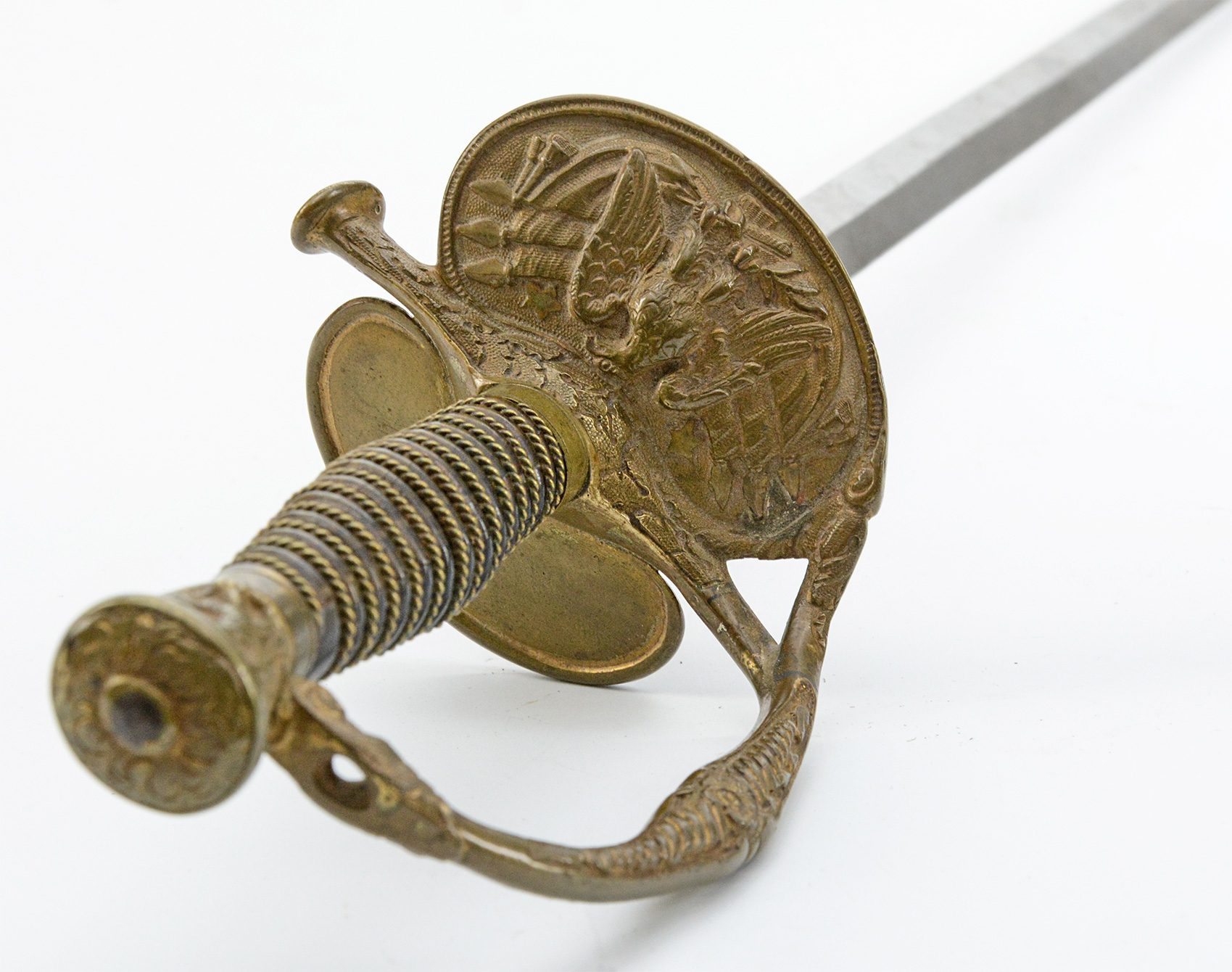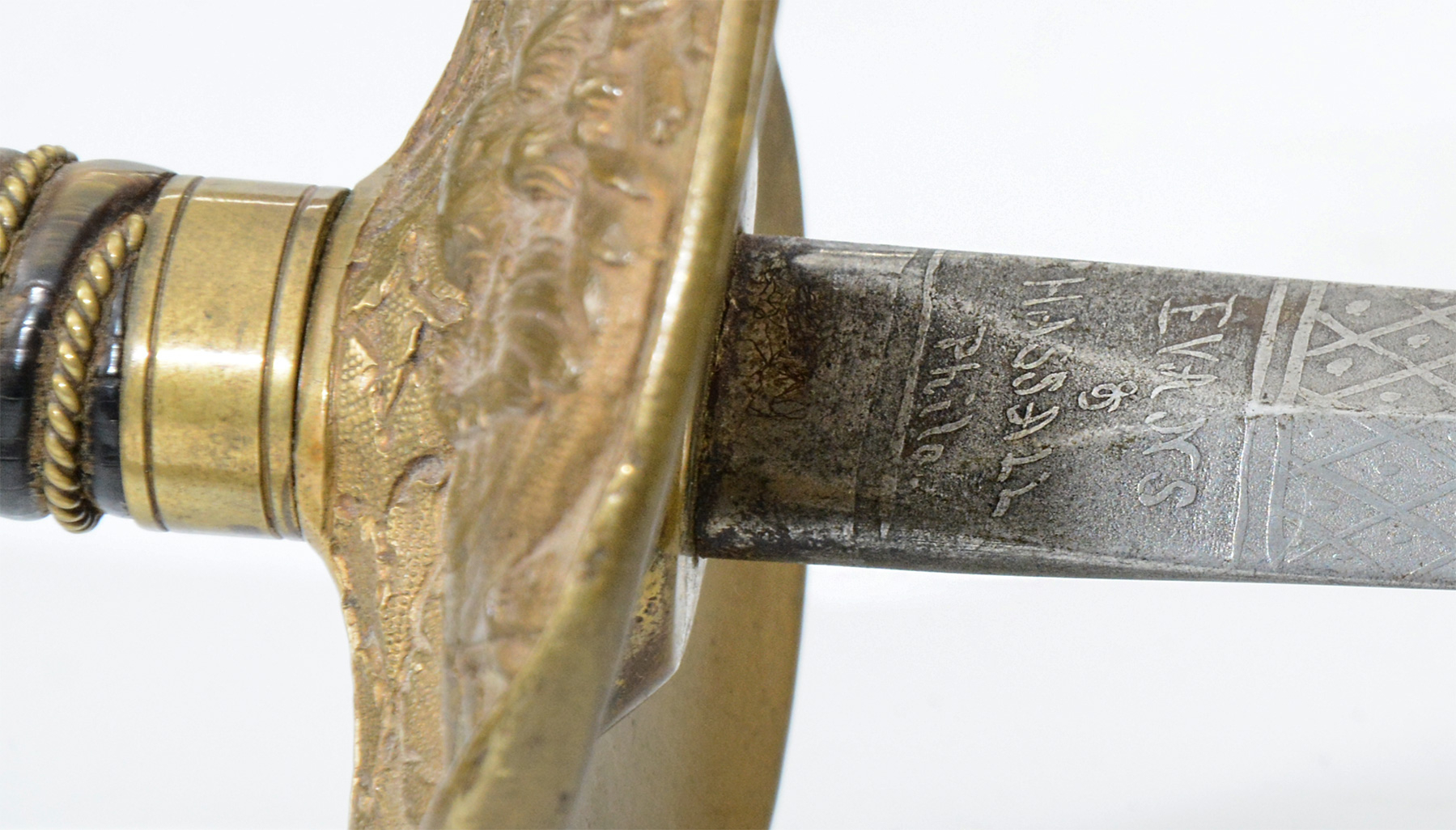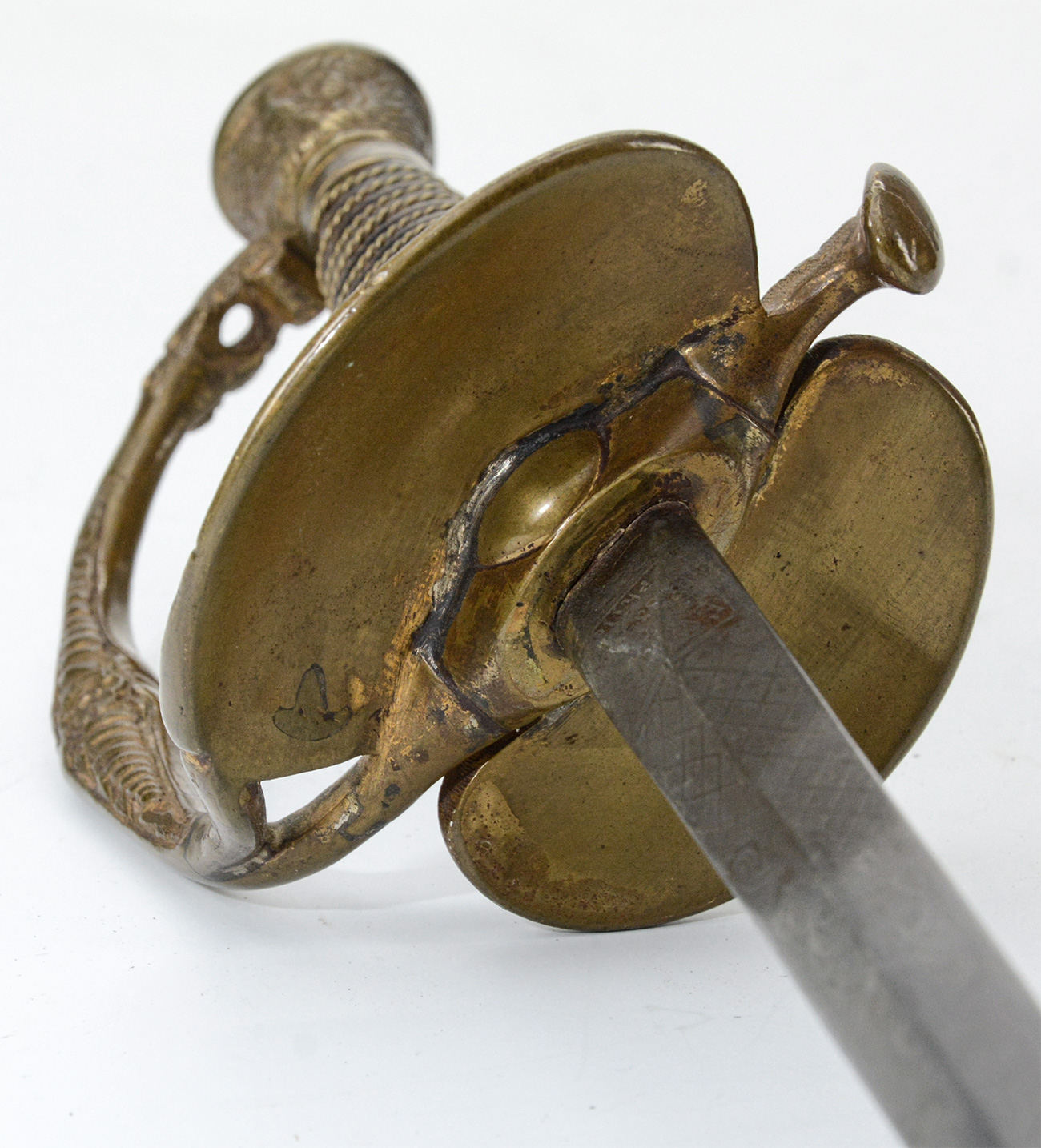site search
online catalog
1860 STAFF SWORD BY EMERSON & SILVER, SOLD THROUGH EVANS & HASSALL

Hover to zoom






$1,195.00 SOLD
Originally $1,595.00
Quantity Available: None
Item Code: 870-404
This 1860 Staff sword bears the keystone blade stamp of Emerson and Silver at the base of the blade on one side and the etched retailer’s address on the other side: “EVANS / & / HASSALL / Phila.” The sword follows U.S. regulations in using a horn grip, but has utilized a hilt with a rigid reverse counterguard, which became the norm after the war as the sword evolved into the 1872 staff and line officer’s sword. In this case the underside of the guard looks like it was cast from a modified mold, with elements of a hinge showing, but with the reverse counterguard made in one piece with the rest of the hilt.
The sword is certainly war period. Evans and Hassall were in business together by 1859 in Philadelphia and out of business by June 1866, with a change of business name in January 1866. Both had worked for Horstmann and they entered the military goods business, selling privately and contracting with the government for fifes, drums, canteens, different types of flags, and “camp and garrison equipage.” Their sword business, however, was limited to privately sold officers’ swords, which they obtained from other sources and etched with their own address, though they may have done some assembly work. Thillmann illustrates examples of their cavalry officers’ sabers made by Ames and by Weyersberg, as well as a non-regulation French style staff and field with a Clauberg blade and non-Clauberg hilt and scabbard elements. It is thus not surprising they marketed an 1860 Staff sword from Emerson and Silver. Emerson later boasted of making “thousands of fine officers’ swords” and more than 100,000 sabers during the war. He also made no secret of supplying blades to others, a revelation before the 1862 Holt Owens Commission that helped torpedo Horstmann’s government contracts.
With the exception of the rigid counterguard, this sword follows the regulation pattern and, with the horn grip, more closely than most. The wire binding is present and tight. Top and bottom brass ferrules are plain. The horn grip is excellent. The lantern pommel has a foliate top, blank shield-shaped plaque on the reverse and spread-winged eagle on branch on the obverse. The knuckleguard is pierced for a knot at top and cast and chased with foliate scrolls at top and a central flower motif at the middle on either side, from which coiled lightning bolts point at pommel and counterguard. As is typical, the knuckleguard splits at bottom, one branch continuing on to form the crossguard and quillon, plain on the reverse to match the plain, reverse counterguard. The obverse of both branches is cast with floral motifs and the obverse counterguard bears a high-relief eagle with no U.S. shield but with arrows and olive branch, superimposed on a panoply of flags. All of this is straight regulation. The brass has a mix of mellow and medium tones, with some traces of gilt. The scabbard shows a mix of blue/brown with narrow brass throat, upper and middle carrying ring bands, and shoe-style drag, matching in tone. The ring bands are cast with floral motifs. The upper band has two carrying rings and the middle band one. Collectors are sometimes doctrinaire about the 1860 staff having only one upper ring, but examples exist with two: Ames went to two-ring upper mounts later in the war and Thillmann illustrates at least two high-grade 1860 staffs with them, including one presented in March 1864. The ring bands themselves are also typically early style: narrow and solid cast, rather than long openwork.
The frosting of the blade etching has softened, but the motifs are legible with great motifs. The obverse bears the Evans and Hassall address at bottom, followed by diamond latticework and floral motifs with the mottos “CONSTITUTION” and “UNION” in diagonal bands. The reverse, bearing the keystone mark, has a starburst at bottom and similar floral decoration, but with the motto “ONWARD / TO / VICTORY” in an elaborate, curling foliate scroll, along with an entwined U.S. in a tall laurel wreath tied at the bottom. A nice parallel for some of the etching, particularly the “Onward to Victory,” appears on an Emerson and Silver supplied 1860 Staff sword retailed by Tomes Son & Melvain, discussed in U.S. Army Swords, p.452ff.
This is a nice sword in great condition. The pattern was derived from the 1840/41 patterns for staff officers and for general officers and overlapped on the early side with the 1834 series and with the 1850 patterns as well, right through the war. Though designated for “officers of the general staff and staff corps,” it was attractive and practical enough that general officers are sometimes photographed wearing it. [sr] [ph:m]
~~~~~~~~~~~~~~~~~~~~~~~~~~~~~~~~~~~
THIS ITEM, AS WITH ALL OTHER ITEMS AVAILABLE ON OUR WEB SITE,
MAY BE PURCHASED THROUGH OUR LAYAWAY PROGRAM.
CLICK HERE FOR OUR POLICIES AND TERMS.
THANK YOU!
Inquire About 1860 STAFF SWORD BY EMERSON & SILVER, SOLD THROUGH EVANS & HASSALL
Most Popular
Historical Firearms Stolen From The National Civil War Museum In Harrisburg, Pa »
Theft From Gravesite Of Gen. John Reynolds »
Selection Of Unframed Prints By Don Troiani »
Fine Condition Brass Infantry Bugle Insignia »
featured item
CIVIL WAR COMMERCIAL FORAGE CAP WITH MAINE BUTTONS AND ASSOCIATED INSIGNIA
Commercial caps were simply those purchased privately rather the issued by the government. They might more or less closely follow contract patterns with the purchaser able to suit his taste and wallet, though an enlisted man, seeking something nicer… (1052-139). Learn More »
site search
Upcoming Events
The shop is currently closed so that we may conduct our annual inventory. We are available by phone… Learn More »


